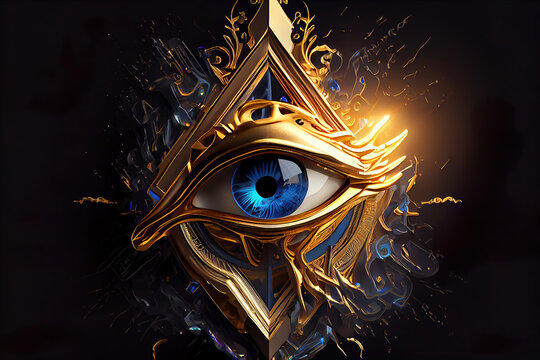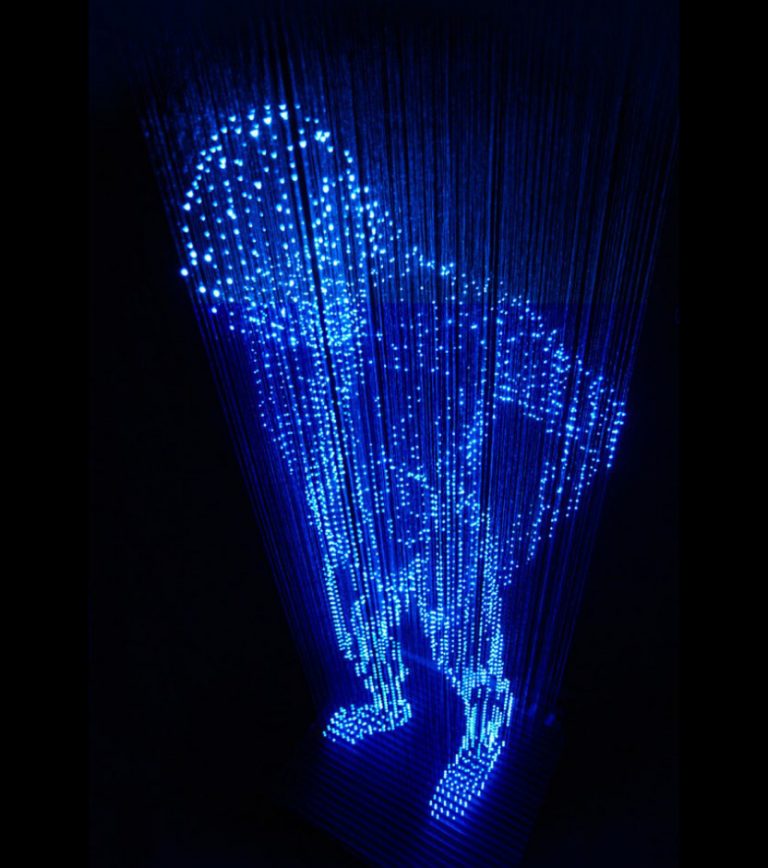Eye of Horus Spiritual Meaning: Protection Against Harm
The Eye of Horus is an ancient Egyptian symbol that represents protection, royal power, and good health. Known also as the Wadjet, this magical symbol was used for its mystical and protective powers by ancient Egyptians and remains an iconic symbol to this day.
In Egyptian mythology, Horus was a powerful sky god, usually depicted as a falcon. The name Horus comes from the Egyptian word “Heru”, meaning “the one on high”. He was considered to be the divine protector of the pharaohs and ruled over the realm of the living as the pharaoh was considered the living god. His right eye came to represent the sun, while his left eye represented the moon.
The Story Behind the Loss of Horus’ Eye
According to legend, Horus lost his left eye during a battle with his uncle Seth to avenge his father Osiris’s murder. Seth tore out Horus’s eye but lost the fight. The eye was restored to Horus by the god Thoth. The myth reflects the waxing and waning cycles of the moon. As the moon waxes and wanes in cycles, so does the Eye of Horus.
After this battle over the throne, Horus was seen as the God associated with the pharaohs, while Seth was considered the patron god of their enemies. The Eye of Horus was viewed as a sign of power and protection and came to symbolize the sacrifice and struggle against one’s enemies.
Meaning and Uses of the Eye of Horus Symbol
The Eye of Horus is viewed as a symbol of life, healing, and protection in ancient Egypt and in modern times. Here are some of the key meanings behind this iconic symbol:
Protection Against Harm
The legend of the Eye of Horus being torn out but later restored symbolizes the constant struggle to protect oneself against harm. To the ancient Egyptians, the Eye of Horus was a protective force that kept disease, illness, and danger away.
Even today, the Eye of Horus continues to be used as a protective amulet. Many people wear jewelry and talismans adorned with the Eye of Horus to protect themselves from misfortune and illness.
Healing and Regeneration
In Egyptian mythology, Horus’s recovered eye became a symbol of life and regeneration after injury or illness. To this day, the Eye of Horus is associated with healing injuries and illnesses, counteracting the effects of the evil eye, and repairing damage.
Many people will wear the Eye of Horus as a symbol of healing and to speed up recovery from wounds or sickness. The ancient Egyptians would often use amulets with the Eye of Horus on them to promote healing.
Royalty and Power
Since Horus was associated directly with the pharaohs of Egypt, his Eye came to be linked with royalty, power, and authority as well. The Eye of Horus was seen as a sign that the pharaoh was protected by the gods and thus the legitimate ruler.
Even today, the Eye of Horus retains these connotations of status and influence. The symbol is popularly worn by leaders, executives, and those in positions of power and command.
Wisdom, Insight and Knowledge
In ancient Egypt, the Eye of Horus was linked to Re or Ra, the sun god. As a symbol of the all-seeing sun, the Eye came to represent wisdom, insight, clarity, and knowledge.
Horus’s restored eye was said to possess magical abilities, letting the wearer view the world with a godly perspective. Even now, the Eye is associated with illuminating truths, heightening awareness, and developing personal wisdom.
Breakdown of the Six Parts of the Eye of Horus
The Eye of Horus is depicted in ancient Egyptian art and iconography in a stylized form with six parts. Each of these six fractions represented a different sense or concept and was linked to a particular god or goddess.
Hieroglyph for “Healing”
The right side of the Eye corresponds to one half, representing smell. This section is associated with the goddess Isis and healing.
Hieroglyph for “Flowing Water”
The pupil corresponds to one quarter, representing taste. This section is associated with the god Nephthys and water.
Hieroglyph for “Actions”
The eyebrow corresponds to one eighth, representing thought. This section is associated with the god Atum and air.
Hieroglyph for “Corner”
The left side of the Eye corresponds to one sixteenth, representing hearing. This section is associated with the goddess Serket and darkness.
Hieroglyph for “Liquids”
The curved tail corresponds to one thirty-second, representing touch. This section is associated with the god Qebehsenuef and fire.
Hieroglyph for “Lord of the Universe”
The teardrop corresponds to one sixty-fourth, representing sight. This section is associated with the god Thoth and light.
The Eye of Horus Today
The Eye of Horus continues to be used in jewelry, tattoos, clothing, and as a protective emblem in modern times. It remains a popular symbol affiliated with ancient Egypt, the occult, protection, royalty, and superstition.
Its meaning has become varied, as many people focus on different aspects of the Eye’s mythology and iconography. Still, certain common threads shine through – ideas of healing, wisdom, power, and safety.
The Spiritual Meaning of the Eye of Horus Symbolizing Love and Healing
The Eye of Horus is strongly associated with healing, restoration, and regeneration in Egyptian mythology. When Horus lost his left eye in a battle with Seth, it represented the dark phase of the moon. The waxing and waning cycles of the moon are symbolic of decay and rebirth. Just as the moon disappears and then grows anew, the Eye of Horus represents the eternal cycle of loss and renewal.
The goddess Hathor, who personifies love, beauty, and joy, magically restored Horus’s injured eye. Her powers brought the Eye back to life. This act of divine love and compassion transformed the Eye into a powerful symbol of rebirth after injury. The myth reflects the Egyptian belief that love has restorative and rejuvenating properties.
So at its core, the spiritual meaning of the Eye of Horus revolves around love’s ability to heal wounds, repair damage, and make whole what has been broken. It is a talisman signifying that no matter how hurt or broken someone may be, love contains the magic to nurse them back to health and vitality.
The Esoteric Meaning Behind the Eye of Horus
Beyond its associations with healing, the Eye of Horus contains layers of esoteric wisdom in its iconography. Each piece of the Eye is linked to a particular sense, goddess, or concept. These meanings hint at the Eye’s role as a map to higher knowledge and spiritual enlightenment.
The right side is tied to the sense of smell and the goddess Isis. Isis was the embodiment of intuition, magic, and mysticism in Egypt. This linkage suggests the Eye can open one’s psychic sight.
The curved tail represents fire and correlates to the sense of touch. Fire is transformative and gives light in times of darkness. This implies the Eye lights the way when one is searching for inner truth.
The teardrop is linked to sight and light. It is associated with Thoth, the god of wisdom. The tear hints that the Eye enables clarity of vision and illuminates the mind with insight and understanding.
So in occult circles, the Eye is believed to activate one’s extrasensory abilities and grant inner illumination on the path to enlightenment. It is seen as the gateway to hidden knowledge about the spiritual nature of reality.
The Color Red in the Eye of Horus and Its Magical Significance
The Eye of Horus is most often shown with red tones. In Egyptian color symbolism, red represents fire, blood, and divine power. It is the color of magic, transformation, and spiritual force.
Red is also affiliated with the goddess Hathor. As the restorer of Horus’s Eye, she infused it with her magic to facilitate its rebirth. The vibrant red hue is thought to be from Hathor’s regenerative energies coursing through the Eye.
By harnessing the color red, the Egyptians believed the Eye of Horus invoked Hathor’s restorative magics to cure illnesses, reanimate the dead, and protect against harmful sorcery. Red empowered the Eye’s supernatural abilities.
So the vibrant red tones in the Eye of Horus highlight its connection to magical practices. The color endows the Eye with otherworldly potency to heal, bless, transform, and illuminate those who wield its powers.
The Eye of Horus as an Emblem of Occult Power and Mysticism
Many mystical schools incorporate the Eye of Horus into rituals and teachings about the hidden nature of reality. Beyond physical sight, the Egyptians believed the Eye could see into the spiritual realm.
The Eye’s symbolism resonates with the occult concept of a “third eye.” Just as Horus’s restored eye offered him clarity and wisdom, the third eye signifies an inner portal to accessing higher consciousness.
Mystics believe the Eye of Horus aids in opening the third eye. As an emblem of magic and alchemy, the Eye is thought to attune one’s awareness to realms beyond the physical. Its red tones also signify the Eye’s ability to transform consciousness to a higher state.
So in contemporary magical practice, the Eye serves as a conduit to supernatural vision, arcane revelation, and awakening psychic gifts. It allows practitioners to pierce the veil separating the mundane from the mystical.
The Allure of the Eye of Horus in Tattoos
Due to its mystical potency, the Eye of Horus remains a popular symbol in tattoos. The Eye’s red and black tones make for an aesthetically striking and meaningful tattoo.
Beyond looks, the Eye of Horus contains multilayered meaning perfect for body art. As a tattoo, the Eye symbolizes healing, wisdom, illumination, magic, and protection. It awakens spiritual sight, guards against darkness, and signals goddess-given power.
The Eye further aligns with key tattoo values like personal growth, resilience, and inner transformation. Just as tattoos mark life’s journey, the Eye reflects the soul’s process of restoration after trauma.
So whether to signify spiritual insight, magical gifts, or recovery from life’s wounds, the Eye of Horus’s mystical energy translates beautifully into body art. Its ancient symbolism still resonates in the modern world.
Conclusion
The Eye of Horus is truly a timeless symbol that invokes spiritual meaning and deep resonance whether in the context of ancient Egypt or the modern world. Its mythology and aesthetic ensure it is one of the most enduring icons of the ancient world.
FAQs
What does Eye of Horus symbolize?
The Eye of Horus is an ancient Egyptian symbol that represents healing, protection, sacrifice, and royal power. According to the myth, Horus lost his left eye in a battle with Seth, who tore the eye into six parts. The goddess Hathor magically restored the eye, giving it healing power. So the Eye of Horus symbolizes the concepts of restoration, healing, and regeneration after harm or injury. It is also seen as a protective force that wards off evil.
What happens when you wear the Eye of Horus?
Wearing the Eye of Horus is believed to invoke the magical healing and protective powers it represents. It safeguards the wearer from illness, misfortune, accidents, and the evil eye. The Eye of Horus is thought to extend the blessings of the gods over someone adorned with its image. So wearing it as jewelry or a talisman provides health, vitality, safety, and fortune.
What is the energy of the Eye of Horus?
The Eye of Horus radiates energies of healing, restoration, intuition, magic, and spiritual protection. Its vibrant red tones signify the vigorous, divine energy that flows through the Eye after it was brought back to life by the goddess Hathor. The Egyptians believed this vibrant, sacred energy could reanimate the dead, cure the sick, and smite enemies. So the Eye of Horus channels the supernatural, regenerative power of the gods.
What does it mean when you see the Eye of Horus in a vision?
Seeing the Eye of Horus in a vision, dream, or meditation suggests you are in need of healing, clarity, or protection in your life. The appearance of Horus’s Eye is thought to activate its mystical powers to restore what is damaged, reveal hidden truths, and guard against harmful forces. So sightings of the ancient symbol signify that restoration and spiritual insight are at hand.







